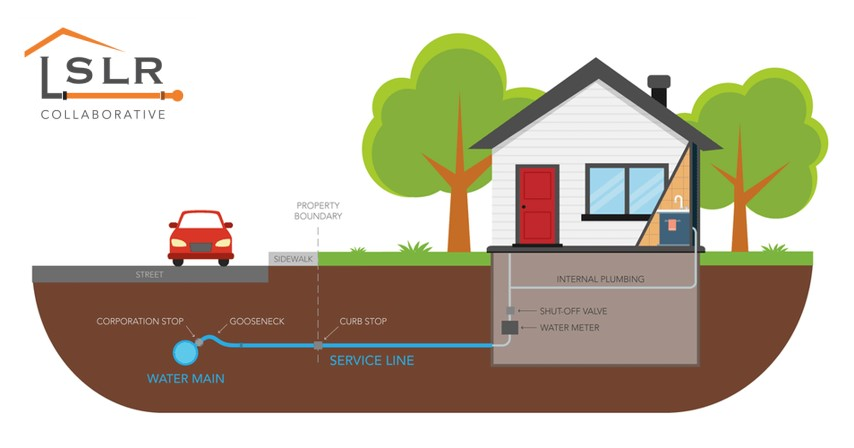It is important to note that the information contained in this website is based on the Lead and Copper Rule Revisions (LCRR) published on Jan. 15, 2021 and may change.
This webpage will be updated as more information becomes available.
On Dec. 16, 2021, the U.S. Environmental Protection Agency (EPA) announced that the Lead and Copper Rule Revisions (LCRR), would go into effect to support development of actions to reduce lead in drinking water. The intent of the LCRR is to identify and replace all lead pipes in communities across the nation. The LCRR compliance date is Oct 16, 2024.
EPA is currently developing the Lead and Copper Rule Improvements (LCRI) to be announced before the above-mentioned compliance date. The LCRI seeks to clarify the following:
- Lead Service Line Replacement Plans,
- Compliance Tap Sampling Protocols,
- Action and Trigger Levels,
- Prioritizing Historically Underserved Communities
The North Dakota Department of Environmental Quality, Drinking Water Program (NDDEQ) will update systems with information on the LCRI once changes are confirmed
EPA has directed states and public water systems to prioritize developing lead service line inventories. Each water system must submit its LSLI to the NDDEQ by Oct. 16, 2024. The date for complying with the Lead Service Line Inventory will not change with the Lead and Copper Rule Improvement updates.
Water Systems Must Follow the Definitions Below When Developing Their Lead Service Line Inventory:
- Service Line: The pipe from the discharge of the corporation fitting to customer site piping or to the building plumbing at the first shut-off valve inside the building, or 18 inches inside the building, whichever is shorter
- System’s that Have Master Meters: For this inventory (at this time) systems that currently have a Master Meter/s, the connection will be considered a single hook-up for the provider. This might change as future guidance is provided to the State and PWS from EPA.
- Partial Service Lines: All partial service lines that contain lead and/or other unknown pipe material, are considered a lead service line under the LCRR. The service lines will need to be replaced unless identified as nonlead.
Lead Service Line Inventory Requirements
All Community Public Water Systems (CWS) and Non-Transient Non-Community Public Water Systems (NTNCWS) must develop and submit a Lead Service Line Inventory by Oct. 16, 2024.
- A Lead Service Line Inventory is necessary for
- 1) Ensuring compliance with lead & copper sample site requirements,
- 2) Development of a lead service line replacement plan,
- 3) Potential funding of lead service line replacement.
- Lead Service Line Inventory will be required to be updated or recertified periodically.
- Lead Service Line Inventory will include every service line in the system, (whether connected or not). They must document material(s) present and approximate age of components on both the private and public side of the system. Systems may list some segments or the overall service line classification as “unknown.”
- “Unknown” service lines will be counted as Lead Service Lines under the LCRR rule until verified that they are non-lead containing.
- System must identify all commercial, industrial, public, or residential building types connected to a service line within the Lead Service Line Inventory. The LCRR require community water systems to prioritize sampling sites such as single-family and multi-family residents with Lead Service Lines, galvanized lines, and other respective sites. NTNCWS may also sample buildings with Lead Service lines, galvanized lines, and representative sites.
North Dakota public water systems may download and use the North Dakota Preliminary Lead Service Line Inventory Spreadsheet to record their system’s inventory.
North Dakota’s Preliminary Lead Service Line Inventory Spreadsheet Form
Updated March 2024
Guidance for the North Dakota Preliminary Lead Service Line Inventory Spreadsheet (pdf)
Updated February 7, 2023 (Correction made to Document)
This document explains how to develop a Lead Service Line Inventory (LSLI) using the North Dakota Preliminary Lead Service Line Inventory spreadsheet template. LSLIs are required by the Lead and Copper Revised Rule (LCRR) passed by Congress in 2022. LSLIs must be submitted to the North Dakota Department of Environmental Quality – Division of Municipal Facilities no later than October 16, 2024.
North Dakota Community Water Systems (CWS) and Non-Transient Non-Community Water Systems (NTNCWS) interested in receiving assistance in developing their Lead Service Line Inventory may email their contact information to NDSRF@nd.gov and request that they be added to the list for potential assistance.
How to Start Your Service Line Inventory
Review System’s Records Such As:
- Tap cards
- Meter replacement/ installation data
- Water main construction and replacement records
- Capital improvement projects that impact service lines
- Ownership of every service line whether private or public side
- Studies (leak studies), replacement plans and sampling data, indicating where Lead Service Lines are and have been replaced by either the private owner or PWS
- Municipal codes
- Inspection and maintenance records
- Water Asset Management Plan
- Permit files
- Billing records
- Prior Lead and Copper sample site plans listing Lead Service Lines
- Tax assessors' records (city or county)
- Timeframe of building and tap construction
- Building and plumbing codes in use during the timeframes
- Typical building materials and practices used
Designate Service Line Material for Both the Public and Private Side Categories in The Inventory Spreadsheet As:
- Lead
- Copper
- Galvanized steel, (Galvanized means Zinc coated metal)
- Unknown
- PEX
- Non-lead
- HDPE (High-Density Polyethylene)
- PVC
Unknown service lines will be treated as Lead Service Lines and will need to be replaced or identified in the future by the PWS.

Sandi Washek
NDDEQ Rule Manager
701-328-5190
swashek@nd.gov